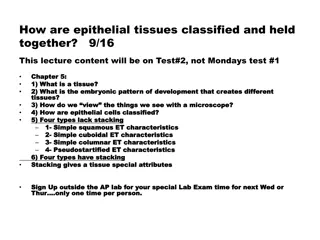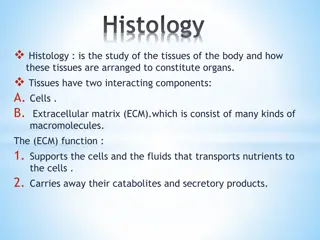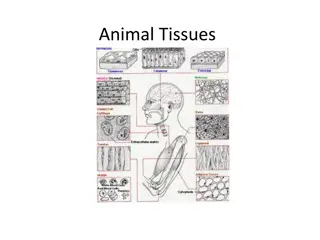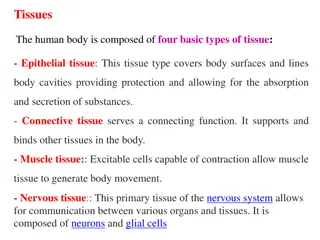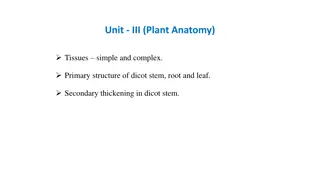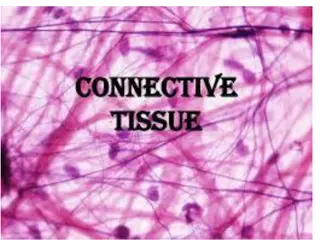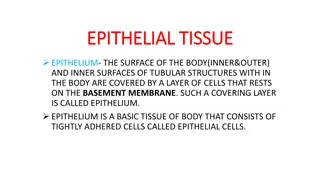Understanding Epithelial Tissues
Epithelial tissues are a vital part of the human body, serving functions such as protection, secretion, and absorption. Learn about the characteristics, classifications, and locations of epithelial tissues, including simple squamous and cuboidal epithelium.
Download Presentation

Please find below an Image/Link to download the presentation.
The content on the website is provided AS IS for your information and personal use only. It may not be sold, licensed, or shared on other websites without obtaining consent from the author.If you encounter any issues during the download, it is possible that the publisher has removed the file from their server.
You are allowed to download the files provided on this website for personal or commercial use, subject to the condition that they are used lawfully. All files are the property of their respective owners.
The content on the website is provided AS IS for your information and personal use only. It may not be sold, licensed, or shared on other websites without obtaining consent from the author.
E N D
Presentation Transcript
Tissues Introduction a group of similar cells specialized to carry on a particular function tissue = cells + extracellular matrix nonliving portion of a tissue that supports cells 4 types epithelial = protection, secretion, absorption connective = support soft body parts and bind structures together muscle = movement nervous = conducts impulses used to help control and coordinate body activities
Epithelial Tissues Characteristics free surface open to the outside or an open internal space basement membrane anchors epithelium to underlying connective tissue lack blood vessels readily divide (ex. skin healing) tightly packed with little extracellular space
Epithelial Classifications classified based on shape and # of cell layers shape squamous = thin, flat cells cuboidal = cube-shaped cells columnar = tall, elongated cells number simple = single layer stratified = 2 or more layers
Epithelial Locations cover body surfaces, cover and line internal organs, and compose glands skin cells, cells that line the stomach and small intestine, inside of your mouth
Simple squamous epithelium a single layer of thin, flattened cells look like a fried egg easily damaged common at sites of filtration, diffusion, osmosis; cover surfaces air sacs of the lungs, walls of capillaries, linings of blood and lymph vessels
Simple cuboidal epithelium single layer of cube-shaped cells centrally located nucleus secretion and absorption surface of ovaries, linings of kidney tubules, and linings of ducts of certain glands
Simple columnar epithelium single layer of cells that are longer than they are wide nucleus located near basement mem. ciliated or nonciliated some have microvilli goblet cells = secrete mucus absorption, secretion, protection linings of the uterus, stomach, and intestine
Pseudostratified columnar epithelium appear stratified b/c nuclei are at 2 or more levels NOT stratified b/c all cells touch basement mem. ciliated goblet cells protection, secretion, movement of mucus linings of respiratory system
Stratified squamous epithelium many layers of flattened cells named based on appearance of top layer of cells protection outer layers of skin, linings of oral cavity, throat, vagina, and anal canal
Stratified cuboidal epithelium 2 or 3 layers of cuboidal cells protection linings of larger ducts of mammary glands, sweat glands, salivary glands, and pancreas
Stratified columnar epithelium protection and secretion vas deferens, part of the male urethra, parts of the pharynx (throat)
Transitional epithelium can stretch distensibility (stretching), protection inner lining of urinary bladder and linings of the ureters and part of urethra
Glandular epithelium cells that are specialized to produce and secrete substances into ducts or into body fluids gland = 1 or more cuboidal or columnar cell secretion salivary glands, sweat glands, endocrine glands
Exocrine vs. Endocrine exocrine = secrete sub. into ducts that open onto surfaces skin or linings of digestive tract endocrine = secrete sub. into tissue fluid or blood hormones
Exocrine glands merocrine = release watery, protein- rich fluid by exocytosis salivary glands, sweat glands apocrine = lose small portions of their cell body during secretion mammary glands, ear wax holocrine = entire cell lysis (breaks apart) during secretion sebaceous glands of the skin
Serous vs. Mucous serous = typically watery with lots of enzymes lubrication mucous = mucus digestive and respiratory systems protection








